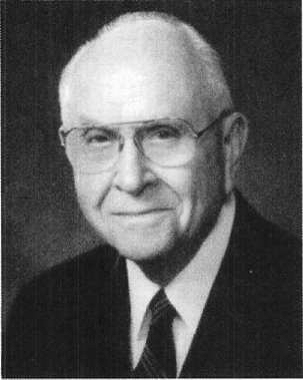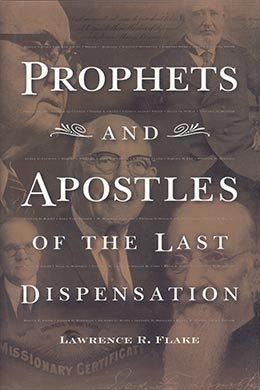David Bruce Haight
Lawrence R. Flake, Prophets and Apostles of the Last Dispensation (Provo, UT: Religious Studies Center, Brigham Young University, 2001), 521–24.

Born: 2 September 1906 Oakley, Idaho
Assistant to the Quorum of the Twelve: 6 April 1970
Quorum of the Twelve Apostles: 8 January 1976 (age 69)
At a large gathering of citizens attending a city council meeting in Palo Alto, California, the mayor did a startling thing. Just before he brought the gavel down to end the meeting, he announced his resignation. A wave of shocked disbelief swept the hall. The mayor was very popular and doing an outstanding job. “Why?” several people nearby asked him. His response:”Because a kindly gentleman in Salt Lake City, who I revered as a Prophet, has called me to go.” [1] The mayor was David B. Haight. The kindly gentleman was President David O. McKay, and the call was to serve as a mission president in Scotland. The people of Palo Alto felt so bad about losing this talented and beloved civil servant that they suggested they protest the mission call by sending a delegation to Salt Lake City. But of course Elder Haight would not countenance such an action. When any call came to serve the Lord, he would go.
David B. Haight was born in the rural community of Oakley, Idaho, on 2 September 1906. His family knew hardship early as the father, a bishop and successful town banker, died of a heart attack when Elder Haight was nine. Elder Haight had already lost one little brother three years earlier, and two more deaths followed in the same year as his father’s—another brother and a sister. His mother valiantly raised the family in spite of her own failing health. Very early, Elder Haight had adult responsibilities and learned to work hard. He was, however, a typical boy. When he was twelve, he decided to try his hand at driving the family Ford. He got it going but didn’t know how to work the brake, so he just drove it around and around the block until it finally ran out of gas. [2]
Needing to earn money for a college education, Elder Haight earned teaching credentials from Albion State Normal School in Idaho. In 1925 he entered what is now Utah State University in Logan and finished his formal education there in 1928. His first job was with the Keith O’Brien department store in Salt Lake City. Some time earlier he had noticed a particular University of Utah student at a dance; he asked his date to arrange to introduce him to her. This same young lady applied to work at the store where Elder Haight was personnel manager. Not surprisingly, he hired her from among five candidates who had applied, and after a two-year courtship, they were married in the temple. From this first job in Salt Lake, Elder Haight began a long and successful career in retail merchandising, which took him first to California, then to Peoria, Illinois, then back to Salt Lake City, to San Diego, and to Palo Alto, California, where he managed a chain of twenty-five stores for Montgomery Ward. In 1943 he interrupted his career to help with the war effort, accepting a commission in the U.S. Navy.
When the war ended, he returned to work for Montgomery Ward. The company transferred him to Chicago, where he managed 165 stores and thousands of employees. In 1949 he returned to Palo Alto and soon afterward purchased a company, beginning his own retail business. He became increasingly influential in Palo Alto. Elder Haight became the stake president there in 1951, serving for twelve years. The Haight home was a haven for students attending Stanford University. Many of these bright young scholars, sometimes confused by the ideas they encountered, looked to the Haights for strength and solace. “There are many young people all over the country who were preserved in righteousness by the sanctuary of the Haight home,” Elder Marion D. Hanks said. “They ate there, read there, even slept there, for the door was always open to them. President Haight would invite people to come in and talk with the students from early evening until midnight. He was fighting for their lives.” [3] Elder Haight’s daughter, Karen, remembered hearing her father tell the students, “The gospel is simple. Don’t complicate it.” [4]
Following his return from three and a half years as a mission president, Elder Haight joined BYU in directing its development and fund-raising program. During that time, he was also a regional representative and served on the Church Missionary Committee. In 1970, after three years at BYU, he was called as an Assistant to the Twelve. In January 1976 President Spencer W. Kimball telephoned him from the Salt Lake Temple, asking Elder Haight to come and meet with him in that sacred building. The prophet ushered him into a small private room and called him to fill the vacancy left in the Quorum of the Twelve Apostles by the death of President Hugh B. Brown. President Kimball took Elder Haight immediately into the assembly of the Twelve: “It was an experience that words cannot describe. I was ordained an apostle and set apart as a member of the Council of the Twelve.” [5]
Twenty years later, in 1996, Elder Haight joined the ranks of ten previous apostles who had the distinction of reaching the age of ninety. The girl he gave a job to in 1928 is still by his side: “Ruby and I were married in the right way, sealed in the temple with its divine covenants and commitments that promote trustworthiness, faithfulness, devotion, and dedication. Now, after sixty-five wonderful years, we look back on our time together and realize that it gets better as time goes on.” [6]
Notes
[1] Dell Van Orden, “A Life Dedicated to Service,” Church News, 20 March 1976, 4.
[2] C. Terry Warner, “Elder David B. Haight,” Ensign, October 1976, 6.
[3] Warner, “Elder David B. Haight,” 10.
[4] Ronald E. Poelman, “Elder David B. Haight,” Ensign, September 1986, 13.
[5] “New Apostle is Appointed,” Church News, 10 January 1976, 3.
[6] Conference Report, October 1995, 98; see also Lucile C. Tate, David B. Haight: The Life Story of a Disciple (Salt Lake City: Bookcraft, 1987).
